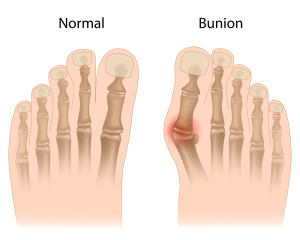Another name for this condition is hallux valgus meaning that the big toe is bent away from the center line. In this condition there is an angle between the first metatarsal bone and the bones of the big toe.
Up to 9 degrees is normal, but anything exceeding 9 degrees is abnormal. Mild bunions are from 9-13 degrees, moderate bunions from 14 to 20 degrees, severe bunion deformity is anything larger than 20 degrees.
Consequence of untreated bunion
Untreated this condition leads from annoying intermittent pain to constant pain at the base of the affected big toe. Often both metatarsophalangeal joints are affected with the one perhaps slightly more than the other. It is much more common in women, partly because of wearing high heels and narrow forefoot boxed shoes.
Diagnostic tests consist of X-rays in the standing (weight bearing) and lying (non-weight bearing) positions. The angles can then be measured and in connection with the examination and clinical impression any surgical procedure can then be planned. Here is a list of some of the surgical procedures (modified from Ref.3).
Bunion (hallux valgus) surgery
| Severity of bunion: | Description of procedure: |
| mild bunion (9° to 12°) | soft tissue procedure (modified McBride) or distal osteotomy (Mitchell or chevron procedure) |
| moderate bunion (14° to 20°) | combination of soft tissue release and proximal osteotomy |
| severe bunion (above 20°) | consider arthrodesis of MP joint |
The principle of the surgical procedures of bunions is that the podiatrist or surgeon wants to correct the abnormality with the minimum required procedure possible.
When the surgeon normalizes the angle between the first metatarsal bone and the big toe, the wear and tear of the metatarsophalangeal joint (MP joint) stops. This means that the development of osteoarthritis slows down. Mild and moderate bunions can be corrected as shown in the table.
Osteoarthritis as consequence of severe bunion
However, with a severe bunion the patient has usually already a certain degree of osteoarthritis. The best course of action in this case is to create a bony stiffness (called “arthrodesis”) in the MP joint. This will control the pain, but leave the patient with a stiff joint, which the patient usually tolerates a lot better than a chronically painful condition. Usually after surgery there is more stiffness in the MP joint than before as the soft tissue scarring takes away some of the connective tissue pliability.
References
1. ABC of rheumatology, second edition, edited by Michael L. Snaith , M.D., BMJ Books, 1999. Chapter 5.
2. The Merck Manual, 7th edition, by M. H. Beers et al., Whitehouse Station, N.J., 1999. Chapter 270.
3. Wheeless’ Textbook of Orthopaedics: http://www.wheelessonline.com/
4. The Merck Manual, 7th edition, by M. H. Beers et al., Whitehouse Station, N.J., 1999. Chapter 60, p.487
5. Goldman: Cecil Textbook of Medicine, 21st ed.(©2000)W.B.Saunders
6. Ferri: Ferri’s Clinical Advisor: Instant Diagnosis and Treatment, 2004 ed., Copyright © 2004 Mosby, Inc.
7. Rakel: Conn’s Current Therapy 2004, 56th ed., Copyright © 2004 Elsevier







